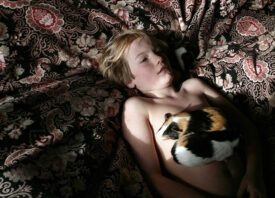Search this site
Welcome to the Dystopian Future



The Kranhäuser, or “crane towers,” are a defining feature of the Rheinauhafen, a waterfront complex in Cologne, Germany, along the west bank of the historic River Rhine. But if you look at Andreas Kremer’s reimagining of the iconic cityscape, you’ll notice something isn’t quite right: the river, once flowing, has dried. In reality, the picture is an elaborately and meticulously constructed fiction, dreamt up by the artist and realized as a photomontage or digital collage.
This scene never happened, but perhaps it does contain just a sliver of truth: you might remember that in 2018, Germany experienced dry summer that, by fall, had left parts of the Rhine at record-low levels. The wreck of an old boat, submerged more than a century ago, emerged, becoming visible above the waterline. Experts predicted this kind of extreme weather would increase as our climate warms.
The Last Resort began as Covid swept the globe. Kremer spent the years leading up to the pandemic traveling, capturing awe-inspiring views of the world’s metropolises from roofs and hilltops. In 2020, suddenly unable to travel amid lockdowns, the artist found himself returning to his archive, pouring over the thousands of images he’d made across Europe and Asia.
Using those pictures, he created fantastical–yet almost disconcertingly believable–collages, juxtaposing natural landscapes and manmade or industrial developments. The resulting images, beautiful but dystopian, became emblems of our time and a potential future for humankind. It’s significant that the idea itself emerged as cities grappled with the pandemic–and important conversations around sustainable urbanization began.
“Beyond their mighty nature, big cities have always fascinated me: this clash of people, cultures, behavior, and ultimately life in every form,” Kremer says. “The negative sides are quickly visible when you leave the tourist trail: poverty, exclusion, fragile social orders. But cities are also where you can find the peaceful coexistence between people with major differences. I often stand in amazement in front of it all.”
The process and creation of the final image usually depend on the concept. “A photo can generate the idea itself, but often, it might also come from a scene from a film or a painting–I have always been a fan of the surrealists, who used collages to refer to social or political grievances,” the artist says. “After the idea, the intensive manual, digital work in Photoshop begins. In this phase, I work for days (and even nights) on the details of an image.
“Two or more images are quickly superimposed in Photoshop, but making the integration seamless and realistic requires a lot more time. During this process, some ideas are discarded because the image material does not give a realistic final impression.” The prints are exhibited large-scale–1.2 meters or more–so everything must be perfect.
Kremer is clear about the fact that he’s not pointing fingers. He’s speaking to issues like climate change, inequality, and poverty, but he’s making art, not judgments. At the same time, he does want to inspire us to be more thoughtful about our planet and our place within it. “Most of the landscapes or urban scenes from the collages, when resegregated, actually exist in reality,” he explains.

“For example, the dystopian landscape with the surreal, solitary, burnt trees in one of the more recent works (Energy I) was actually found in a nature reserve in Belgium. The dystopian impression is created primarily by the different contexts into which the components are integrated. The overall context emphasizes social conflicts and triggers feelings of discomfort, but it also gives the viewer room for interpretation.”
With travel restrictions lifting, Kremer looks forward to exploring the world once more. Even though he’s created thousands of images over the years, he’s itching to add more and continue work on The Last Resort. At the same time, one of his favorite pictures from the series–the image of the Rheinauhafen waterfront–hits closer to home than most, as it was made in the city where he lives. “Personally, I also really like the more subtle images,” he tells me. “An image that I do not understand immediately often remains longer in my mind.”
Kremer is currently exhibiting images from The Last Resort at BBA Gallery in Berlin as part of the BBA Photography Prize Remix show. Starting on April 3rd and running through th beginning of May, The Last Resort will be exhibited at Kunsträume der Michael Horbach Stiftung in Cologne. Signed copies of his latest book TENSION, published by KERBER Verlag, are available upon request.








Andreas Kremer is a winner of Feature Shoot’s Reader Submission Spotlight. Every month, we invite photographers to submit their best bodies of work, with three chosen to be featured on our website and in both our regular and special edition newsletters, going out to an estimated 80,000 people overall, including gallerists, publishers, editors, agents, and more. You can submit your work for consideration here.
All images © Andreas Kremer



